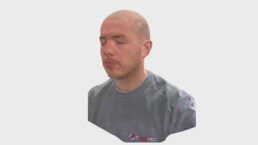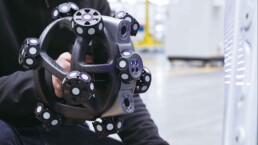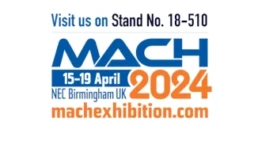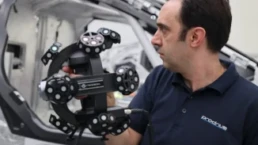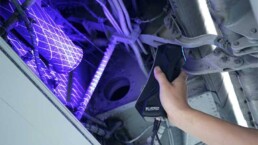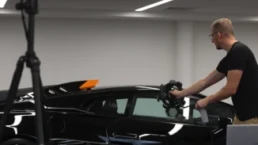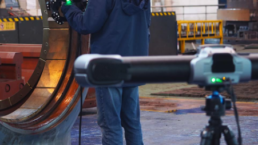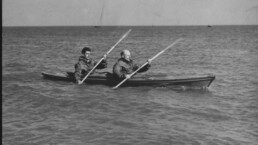Invisible light infrared 3D scanning transforms the way data is captured for facial reconstruction and prosthetics.
Modern technology for 3D scanning and printing in both plastics and metal manufacturing has developed to such a high standard, that medical prosthetics for maxillofacial medicine can now be produced with very realistic levels of detail. What’s more, with systems such as the iReal 2S, scanning can be done quickly, safely and accurately. The oral and maxillofacial surgeons at North Manchester General Hospital (NMGH) have been putting the latest facial scanner from The 3D Measurement Company (T3DMC) through its paces.
Traditionally, the creation of facial prosthetics for trauma patients involved taking an impression of the patient’s face, a procedure which could take up to an hour. The patient has to lie back very still until the impression sets, after which a gypsum stone solution is poured into the mould. Once this hardens, the facial prosthesis will be built around it. The process of taking an impression is not always reliable and can be extremely uncomfortable for some patients, especially for burns and severe trauma patients.
Oliver Burley – Reconstructive Scientist
“In the last few years we have tried to move from traditional methods of mould making to using 3D scanners, which has enabled this process to become quicker, cleaner and more convenient for the patient, explained Oliver Burley – Reconstructive Scientist and Lab Manager at North Manchester General Hospital (NMGH). “The facial scanning technology we had access to in the past was suitable for some applications – such as burn splint manufacture – however the level of detail captured left a lot to be desired. Their ability to capture the intricate detail of patient’s face was not as precise as we’d want it to be. A high level of accuracy is essential for creating maxillofacial devices and facial prostheses that are aesthetically pleasing, fit well, and blend seamlessly with the patient’s own features.”
When trialling the iReal 2S face scanner from T3DMC, the team at NMGH found that the scanner was capturing detailed features such as eyebrows, skin folds, wrinkles and eye position, alongside the pigments and colours for each of them.
Designed for non-industrial applications, the iReal 2S accurately captures details such as hair, skin texture and eyes. What’s more, it does all this without irritating the skin, being safe for patients’ eyes, and it is even suitable for patients’ suffering from epilepsy.
“Compared to other systems we have tried, we found that the iReal met all requirements and applications within the hospital settings”, enthused Mr Burley. “Thanks to the blue and the infrared light settings we can scan a person’s face in thirty seconds and produce a high quality scan. The scanner is light and portable which allows us to easily travel with it between different hospital sites. Furthermore, there’s minimal post-processing required and resulting stl. and obj. files that can be used depending on the need, such as for printing the 3D models. The usability of the scanner is excellent and takes minutes to set up – and there’s no need for extensive training”
Indeed, as one of the most affordable 3D body scanners on the market, the iReal 2S can scan in high definition and in colour without reference markers or dots. The iReal’s ability to capture data at 550,000 measurements per second guarantees a quick and smooth scanning experience. Furthermore the built in HD camera directly captures high resolution full colour images of the scanned object, overlaying them onto the 3D mesh structure to give realistic colour representation of the object. All this is complemented by a visual guidance system which ensures ease of use for non-technical users.
As an added benefit, the data captured with the iReal can later be used for 3D printing and other additive manufacturing techniques to quickly create a prototype for prosthetics.
“After trialling the iReal scanner on the more complex cases, we are now looking at using it as a volume measurement tool for tissue reconstruction on other areas of the body”, added Mr Burley. “The iReal scanner has opened new possibilities for our team at NMGH and dealing with the T3DMC engineers was a fantastic experience from start to finish. I believe this is only one of the many projects we’ll collaborate on!”
If you are interested in exploring how you could benefit from the system please contact us to discuss a 3D scanning solution to meet your needs.
Give us a call on 01746 762251 or contact the team via our website.
Other news articles
7th February 2024
Revving Up Innovation: T3DMC Becomes Prodrive’s Official 3D Scanning Partner
Explore how our 3D scanning partnership with Prodrive is accelerating advancements in motorsport and driving innovation.
29th August 2023
Preserving History With 3D Scanning Technology: The Mk2 Cockle Canoe, Operation Frankton
Preserving history with SIMSCAN. Capturing 3D data of WW2's unsung hero, Operation Frankton's Mk2 Cockle Canoe.

